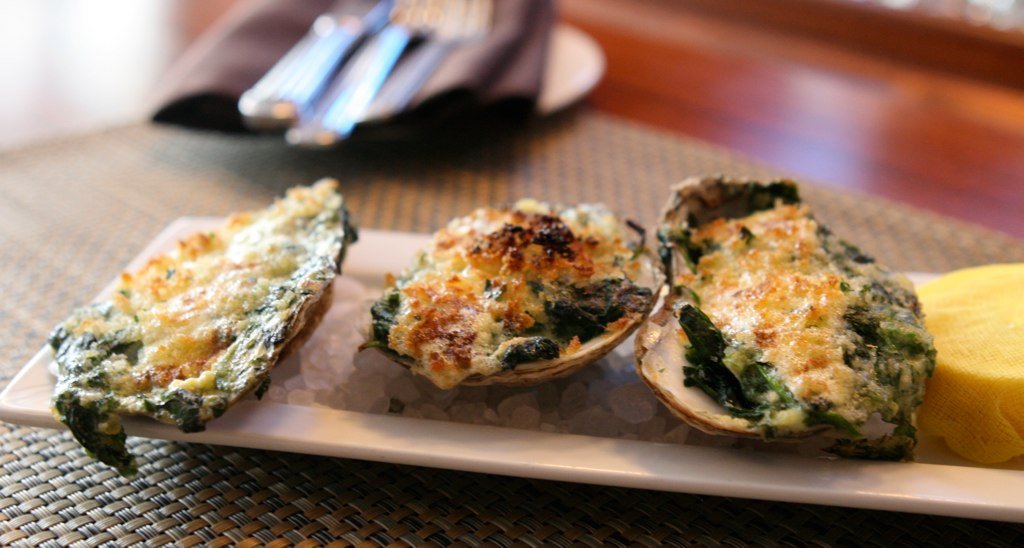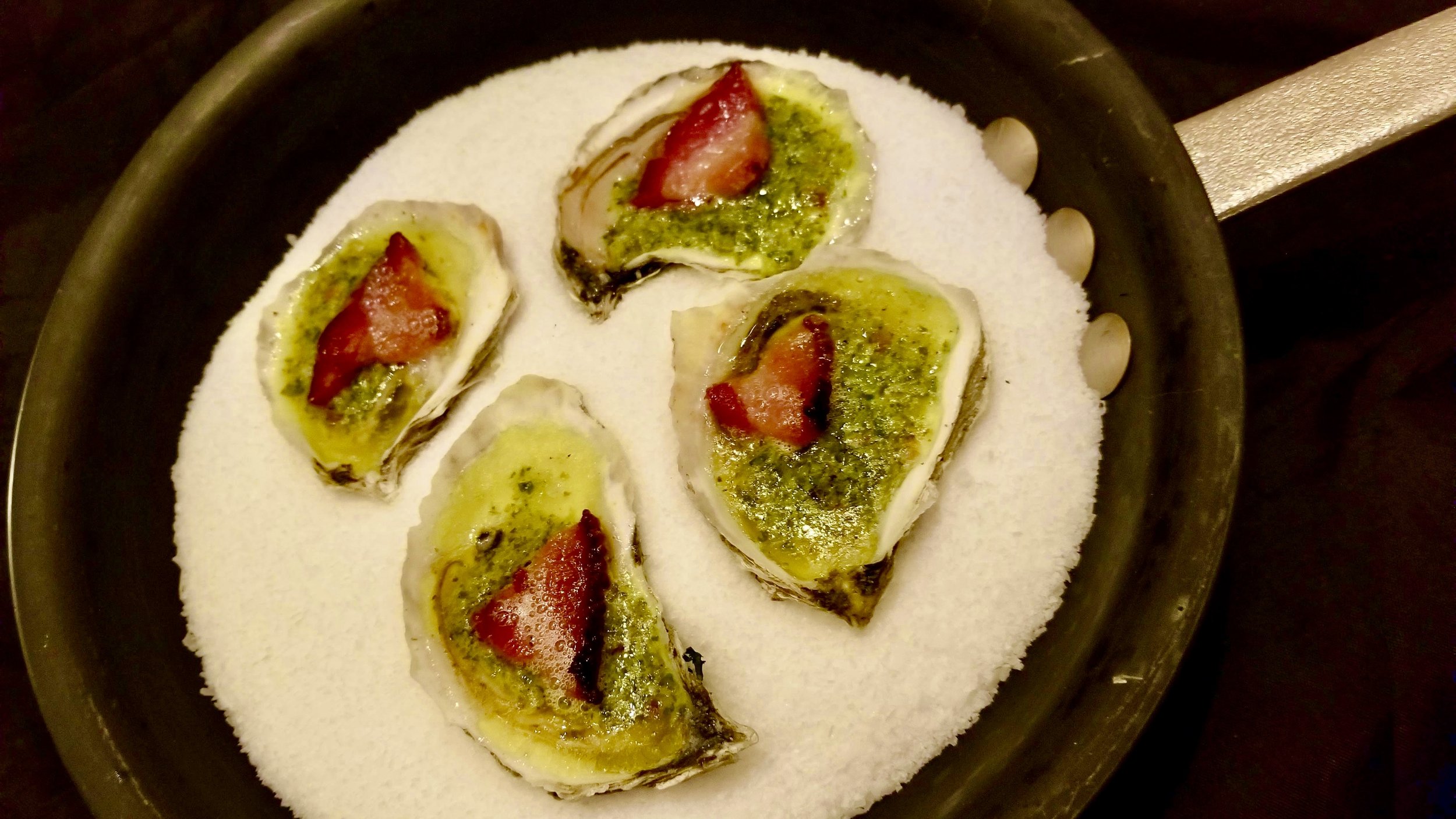THE OYSTER
Be sure to catch the two (2) recipes after the story, one for Oysters Rockefeller, the other for Oysters Casino.
“He was a bold man that first ate an oyster.” — Jonathan Swift
Several years ago, in Seattle, in the course of one evening, I ate 60 oysters.
I was working on a story for a magazine on ales and oysters—which ones tasted best with which ones (porters and stouts came out well)—so I visited five of the city’s brewpubs and ate a dozen of the mollusks at each.
I was certain that, statistically alone, I would sicken overnight, but that did not happen. My hotel was Seattle’s Alexis and, in the morning as the sunlight streamed through the soaring windows of my room like rays beaming into a cathedral, I woke on my back and felt like Zuul, Sigourney Weaver’s character in the original “Ghostbusters,” floating over her bed.
My limbs never had felt so light.
I thought that I had read somewhere that Asian apothecaries sell powdered dried oyster meat for joint or arthritis pain, but that proved to be pharmaceutical myth. But if that’s what 60 oysters will do for a body, bring ‘em on.
Oysters grow on ocean coasts the globe over. No need exists anymore to attend to buying them during months in which the name includes the letter “R.” For us, those months are generally the coldest of the year and allow for both the tastiest growing and the safest shipping conditions.
However, that was the line when air transportation did not allow for the speedy import of oysters from an opposite hemisphere. (Anyway, get them while they’re, well, not in hot water.) For Denver, where I live, due to our sporting the world’s third-busiest airport, many oysters flown overnight here are fresher at the fish counter than those eaten feet away the same day or the next from their taken waters.
It’s astounding to note the history of the popularity of oysters in this country between the War of Independence and the heyday of the Western Expansion. Writers of all sorts and from all parts of the nation tell stories of the shipping paths of oysters from colder sections of the country to its inland reaches; of oyster parlors and saloons that resembled speakeasies; of all manner of uses of oysters in cooking from plain to fancy.
In 1895, some 170 million pounds of oysters were consumed across the U.S. That is down to an annual U.S. consumption of around 40 million pounds today, according to the U.S. Department of Commerce.
Pell’s Oyster House, hundreds of miles from the nearest ocean, operated in downtown Denver for more than 50 years, from the late 1800s until 1937. For that, bless the transcontinental railroad, sturdy oak barrels, ice, and oatmeal for keeping the bivalves alive for days.
Oyster cookery was more popular in this country until the 20th century when a taste strongly developed for raw oysters on the half-shell. Nothing wrong with the latter—as I, Seattle and my 60 would be first to attest—but getting back to cooking with oysters reminds of our common past when, in a way of thinking about it, one of our early regional cuisines, that born of coastal aquaculture, also became one of our truly first national cuisines.
The recipes here cook two famed preparations of oysters. The “Rockefeller” in one name refers merely to the richness of the dish; the recipe originated in New Orleans, far from John D’s home state. The recipe for Oysters Casino is a turn on Clams Casino, originally from Rhode Island, and has little to do, from what I could find, with any gambling.
Use common kosher salt to steady the oysters for the oven and even for service. Food-grade rock salt (what you might find in some recipes such as these) is difficult to find, but a large box of kosher salt is less than $10 at a restaurant supply store, slightly more at a grocery store. The ingredients given are for a dozen oysters; multiply as you and your guests require. In the Rockefeller recipe, cooked fennel substitutes for the traditional few splashes of Pernod liqueur.
A trio of Oysters Rockefeller. Photo from Susan Hoffman on flickr.
RECIPE: Oysters Rockefeller
Makes 12.
Ingredients
12 fresh oysters, shucked, top shell discarded, meat loosened, and resting with their liquor on the bottom shell
1 large or 2 medium scallions, white and light green parts only, chopped
1/4 cup flat-leaf parsley leaves, chopped
1/2 cup fennel, cleaned of fronds, large dice
1 stick unsalted butter, room temperature, separated
Handful baby spinach leaves
2 tablespoons unflavored bread or panko crumbs
Several dashes Tabasco sauce
1 tablespoon Worcestershire sauce
1 box kosher salt
Directions
In 2 tablespoons of the butter, sauté the scallions, parsley, and fennel until cooked through and nicely softened, about 10 minutes. Add to a processor, along with the remainder of the butter and all the other ingredients except the oysters. Blend until smooth and completely incorporated, scraping down a few times to assure that.
To cook the oysters, heat the oven to 450 degrees and position a rack high and under the broiler element so that the oysters will broil at least 2 inches from the heat. Pour the box of kosher salt into an oven-proof pan or skillet and arrange and embed the oyster halves in the salt. Distribute evenly a dollop of the flavored butter onto each. Turn on the broiling element.
Broil long enough to heat the oysters through, rotating the pan if necessary, to evenly distribute the broiling heat, about 5-6 minutes total. Serve, if possible, on the salt.
A quartet of Oysters Casino.
RECIPE: Oysters Casino
Makes 12.
Ingredients
12 fresh oysters, shucked, top shell discarded, meat loosened, and resting with their liquor on the bottom shell
3 slices thick-cut bacon
1 stick unsalted butter, room temperature
1 large or 2 medium scallions, white and light green parts only, chopped
1/4 cup flat-leaf parsley leaves, loose
1/4 green bell pepper, chopped
1 tablespoon lemon juice
Directions
Cook to the halfway point the bacon slices (for example, 2 minutes on high power on paper toweling in the microwave); set aside to drain, then cut into 12 diamond-shaped pieces; reserve. Blend the remaining ingredients in a processor until smooth and completely incorporated, scraping down a few times to assure that.
To cook the oysters, heat the oven to 450 degrees and position a rack high and under the broiler element so that the oysters will broil at least 2 inches from the heat. Pour the box of kosher salt into an oven-proof pan or skillet and arrange and embed the oyster halves in the salt. Distribute evenly a dollop of the flavored butter onto each. Turn on the broiling element.
Broil long enough to heat the oysters through, rotating the pan if necessary, to evenly distribute the broiling heat, about 5-6 minutes total. Serve, if possible, on the salt.


